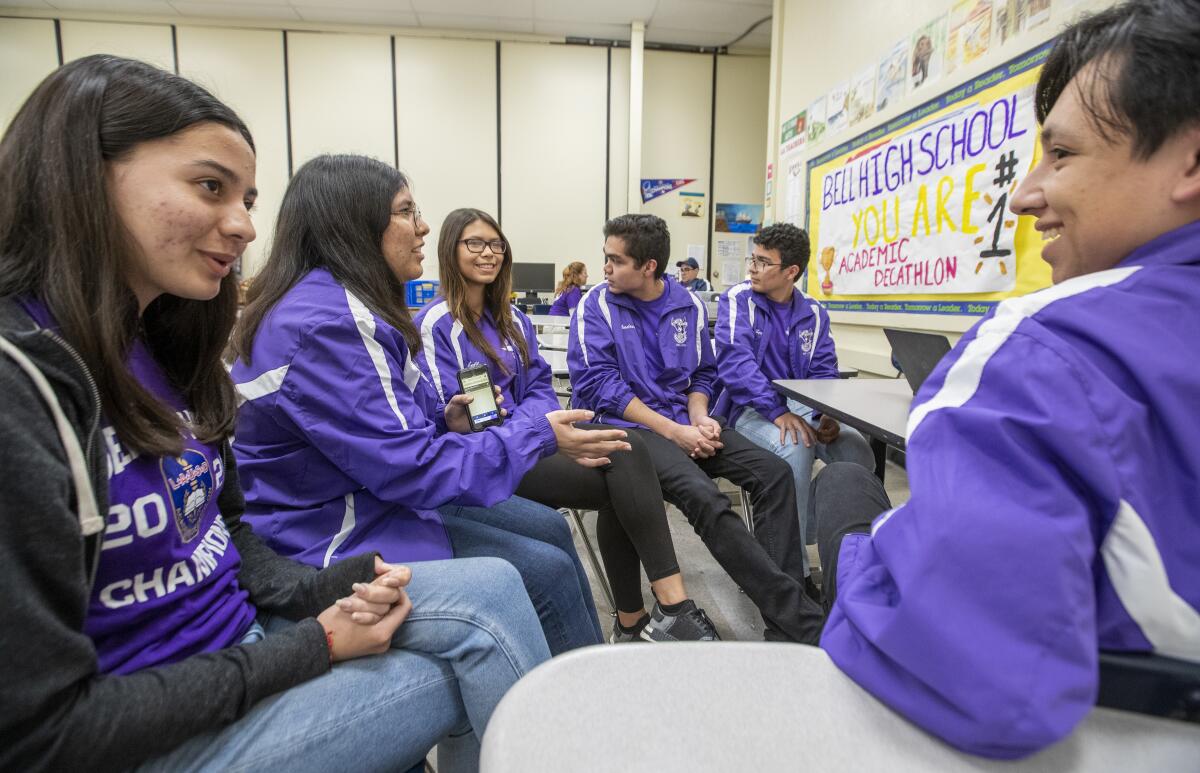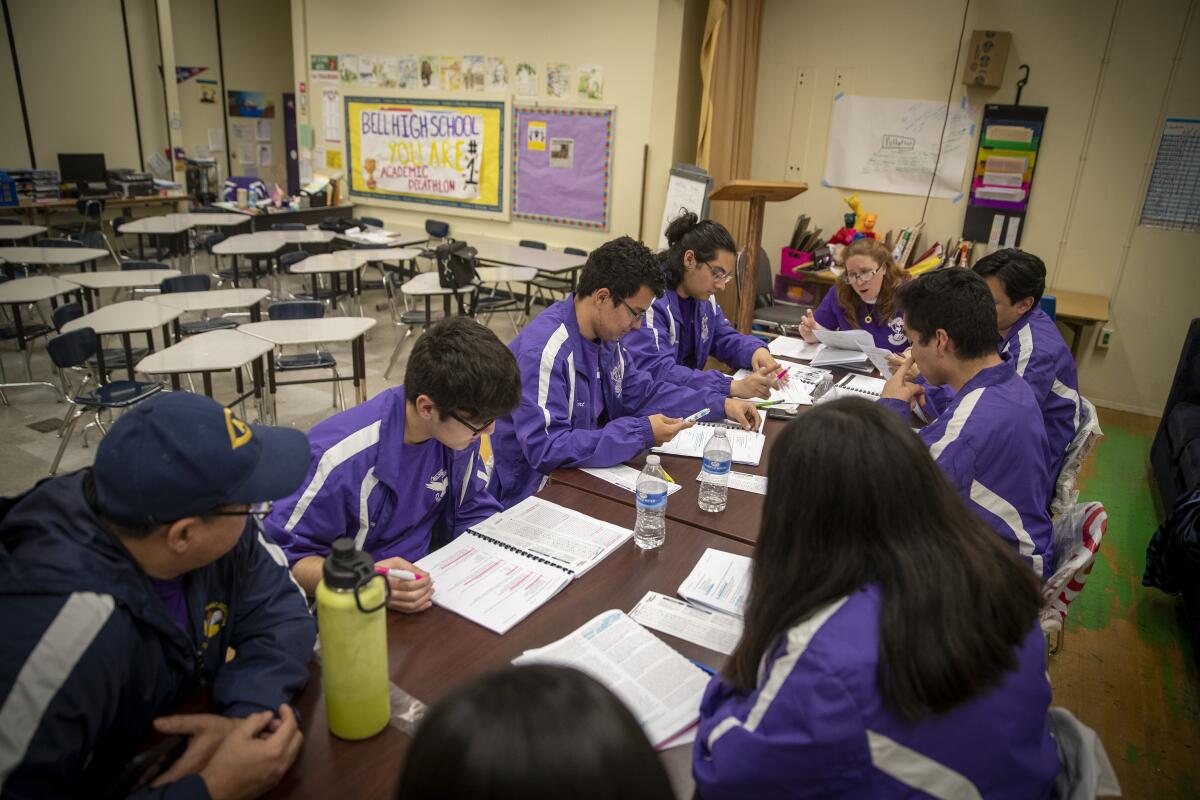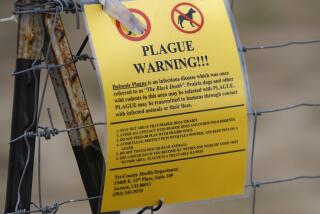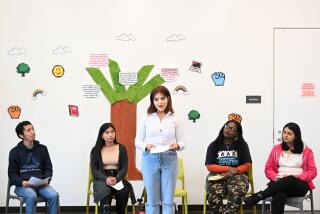This champion academic decathlon team studied pandemics. Now, they’re living one

The subject seemed so remote — medieval maladies spreading illness and death across the globe, altering economies, culture and even history. For the Bell High School academic decathlon team, the L.A. area champions, the Black Death and other pandemics on their study list represented little more than obscure facts to memorize in preparation for state competition.
But now a modern pandemic is unfolding before them, offering perspective and difficult lessons in real time.
“You get to see a lot of parallels with the coronavirus,” said senior Gilbert Castro. During the Black Death, he said, people gradually came to understand that a quarantine had the potential to slow the spread of disease, but there’s so much people did not know.
“Now, you have germ theory and you know this new one is caused by a virus,” he said. “Knowing the science behind the virus, it’s easy to see clear preventives.”
As he spoke, Castro and teammates were studying in the classroom of coach Heather Wilson. The day before, they had suffered a blow. The decathlon organization had notified participants that the late March competition in Sacramento would instead take place online, the last Friday in March, and that portions would be canceled altogether. Then, two days later, the L.A. Board of Education shut down all campuses — a closure now extended till at least May 1.
But these students and their peers are used to overcoming challenges.
Bell High has a 92% poverty rate and more than 80% of students started their schooling still learning English. Most members of the team will likely be the first in their family to complete college. All have immigrant roots.
Their background contrasts sharply with that of Coach Wilson, a transplanted Midwesterner who once worked in the insurance industry. But they’ve come to share her obsessive, strategic quest for excellence — and her belief in them.
This team is no flash in the pan. Last year, it finished fourth in L.A. Unified and 14th in the state. But Bell had never before finished first.
Wilson, an English teacher, began coaching the Bell team 15 years ago, at the start of her third year teaching. At her side most of that time, specializing in science, has been co-coach Matthew Moreno. This year, the team outscored perennial favorite Marshall High and a formidable Grant High squad that placed second each of the last two years.
And the best part was yet to come after their win. The Bell students, especially those on the team for the first time, viewed the camaraderie and adventure of that trip to Sacramento as a highlight of their lives.

“The Sacramento trip is the first thing that comes to mind when I think about the decathlon,” said senior and co-captain Diego Mora, who also participated last year. “All the memories and the experience I got to have with this team. Everybody on this team has worked really hard for it.”
“It is really disappointing,” he said.
Mora and Castro exemplify the sometimes magical formula of the decathlon.
Castro is a straight-A student with an array of advanced placement classes. He was accepted into Caltech and is torn between majoring in physics or math.
Mora, on the other hand, had a cumulative grade point average of 0.6 as a junior. A 1.0 GPA would translate to a D average: “I was actually a really, really, really bad student,” he said, and he initially resisted Wilson’s invitation to try out for the team.
“I thought it was for the nerdy kids, the straight-A students,” Mora said. “But I really liked the idea of being part of a team, the family environment. ... Being stuck in a room with really smart people made me feel like a part of something.”
For his part, the studious Castro was shy and “nervous about talking to strangers” and the decathlon gave him confidence to speak in public and helped him develop close friends among his peers.
The decathlon’s quirky rules require each team of nine to have three A students, three B students and three C students — or in Mora’s case, three students who were C or worse.
Mora’s grades are fine now, but he had so much ground to make up, there was never any chance that he’d rise out of the “C” category. His academic skills, despite being a C student, were representative of the group’s depth and balance.
In the February competition among L.A. Unified schools — L.A. is so big it qualifies as its own region — Mora and Castro tied with fellow senior Armando Aguilar to win five medals apiece — tops on the team.
The overall theme this year is “In Sickness and in Health: An Exploration of Illness and Wellness.” Pandemics are a subtopic.
Co-captain Rubi Espinoza is especially well versed on them. The bubonic plague emerged in 1347, she recounted, probably in Asia and spread to Europe from Crimea and Sicily through shipping and along the Silk Road, a network of trade routes connecting East Asia and Southeast Asia with parts west, all the way to southern Europe.
“A lot of people blamed dirt or like the environment on how fast it spread,” said Espinoza, a senior valedictorian candidate who has been accepted to Stanford. “At that time, since nobody knew how to combat it — that’s how it spread so quickly ... especially because of how populations were so crowded.”
Over five years, the Black Death killed more than 20 million people in Europe — almost one-third of the continent’s population. Centuries later, scientists concluded that the disease was caused by the bacillus Yersina pestis, which spread through touch, through the air and through the bite of infected fleas and rats.
“And it was just interesting how people reacted in different ways,” said Espinoza. “A lot of hysteria; people freaking out. And we could see that today.”
Isabelle Torres, also a senior, agreed: “In some sense people feel more inclined to help each other — or not.”
That night, it was Andrew Vargas’ turn to bring in dinner while the team studied. His father went all-out with grilled steak, rice, beans and salad.
And then, two days later they were packing up their school belongings, strategizing on how to do their 30-plus extra hours a week of study online. The team settled on a gamer app that allows for live group audio.
Danny Arteaga, also a senior, was worried not only about the team but his classes.
“I’m more of a student that is taught mainly through the teacher walking me through a problem and I know that’s for sure the case in calculus,” he said.
Some of freshman Cindy Soto’s thoughts concerned family. Her father, she said, was not feeling well and would normally “power through,” and continue his work as a truck driver. Instead, he was staying at home to recover.
Torres worried about her family making ends meet. Her mother, a single parent, works in a restaurant and relies on tips to supplement wages.
Wilson lent a computer to Mora, because the one he has at home is broken.
“Students are forced to find their own motivation,” Mora said. “I personally have struggled with this because being a ‘good’ student is something that is still new to me... This lockdown is a difficult situation for all of us but I know my team still wants to compete at the highest level we can.”
Armando found some solace in study of past events and California’s aggressive response to the coronavirus emergency.
“The government does take on an important role when protecting the safety of, in this case, Americans,” he said. “We’ve seen a lot of the time in history, when the government did take a stand and did actively try to protect the people’s health, we did see a diminishing in that plague outbreak and eventually an eradication of the disease.”
More to Read
Sign up for Essential California
The most important California stories and recommendations in your inbox every morning.
You may occasionally receive promotional content from the Los Angeles Times.











